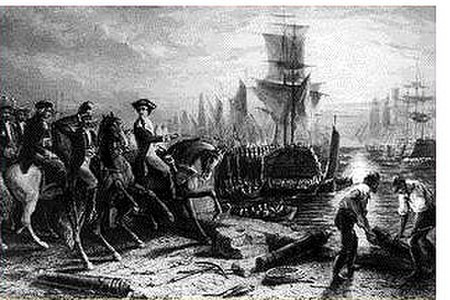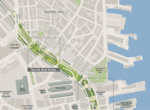Siege of Boston

The siege of Boston (April 19, 1775 – March 17, 1776) was the opening phase of the American Revolutionary War. New England militiamen prevented the movement by land of the British Army, which was garrisoned in what was then the peninsular city of Boston, Massachusetts Bay. Both sides had to deal with resource, supply, and personnel issues over the course of the siege. British resupply and reinforcement was limited to sea access, which was impeded by American vessels. The British abandoned Boston after eleven months and transferred their troops and equipment to Nova Scotia. The siege began on April 19 after the Battles of Lexington and Concord, when Massachusetts militias blocked land access to Boston. The Continental Congress formed the Continental Army from the militias involved in the fighting and appointed George Washington as Commander in Chief. In June 1775, the British seized Bunker and Breed's Hills, from which the Continentals were preparing to bombard the city, but their casualties were heavy and their gains insufficient to break the Continental Army's control over land access to Boston. After this the Americans laid siege to the city; no major battles were fought during this time and the conflict was limited to occasional raids, minor skirmishes, and sniper fire. British efforts to supply their troops were significantly impacted by the smaller but more agile American forces operating on both land and sea and the British consequently suffered from a continual lack of food, fuel, and supplies during the siege. In November 1775, George Washington sent Henry Knox on a mission to bring to Boston the heavy artillery that had recently been captured at Fort Ticonderoga. In a technically complex and demanding operation, Knox was able to bring the cannons to Boston in January 1776 and by March this artillery had fortified Dorchester Heights which overlooked Boston harbor. This development threatened to cut off the British supply lifeline from the sea. British commander William Howe saw his position as indefensible and on March 17 he withdrew his forces from Boston to Halifax, Nova Scotia.
Excerpt from the Wikipedia article Siege of Boston (License: CC BY-SA 3.0, Authors, Images).Siege of Boston
John F. Fitzgerald Expressway, Boston West End
Geographical coordinates (GPS) Address Nearby Places Show on map
Geographical coordinates (GPS)
| Latitude | Longitude |
|---|---|
| N 42.363333333333 ° | E -71.057777777778 ° |
Address
John F. Fitzgerald Expressway
John F. Fitzgerald Expressway
02109 Boston, West End
Massachusetts, United States
Open on Google Maps






